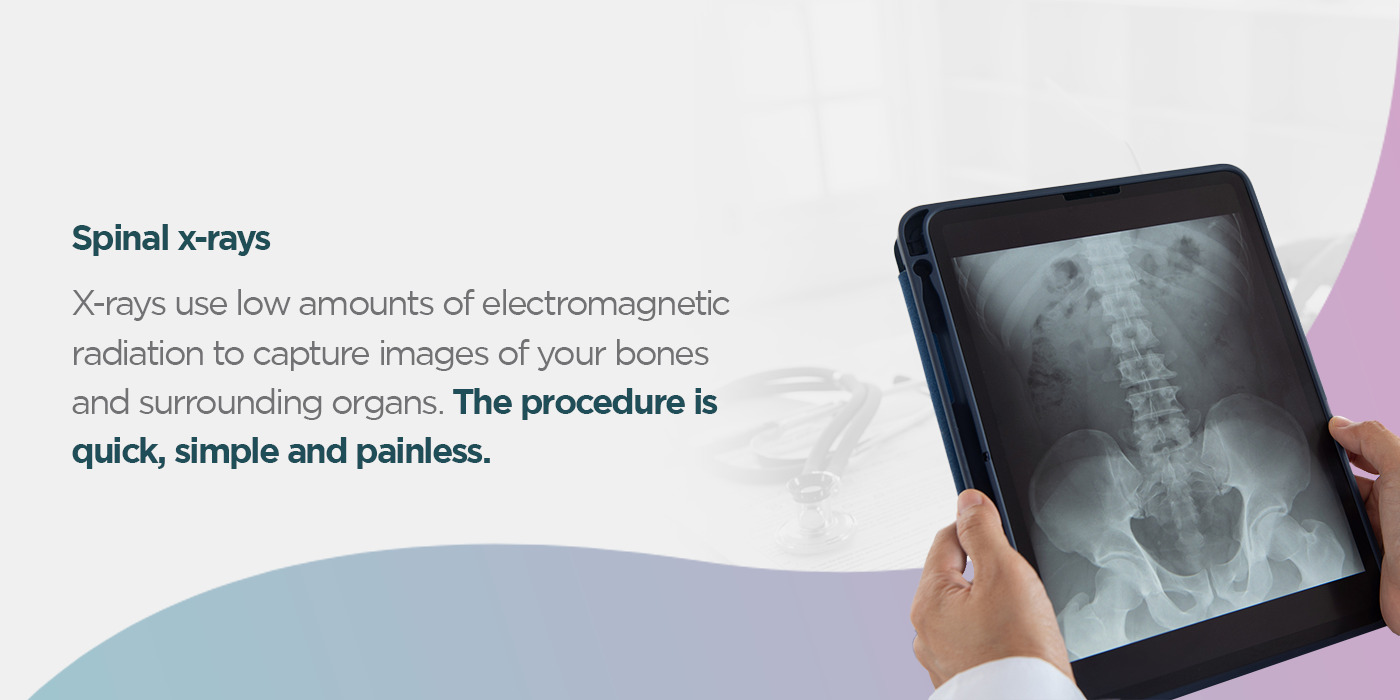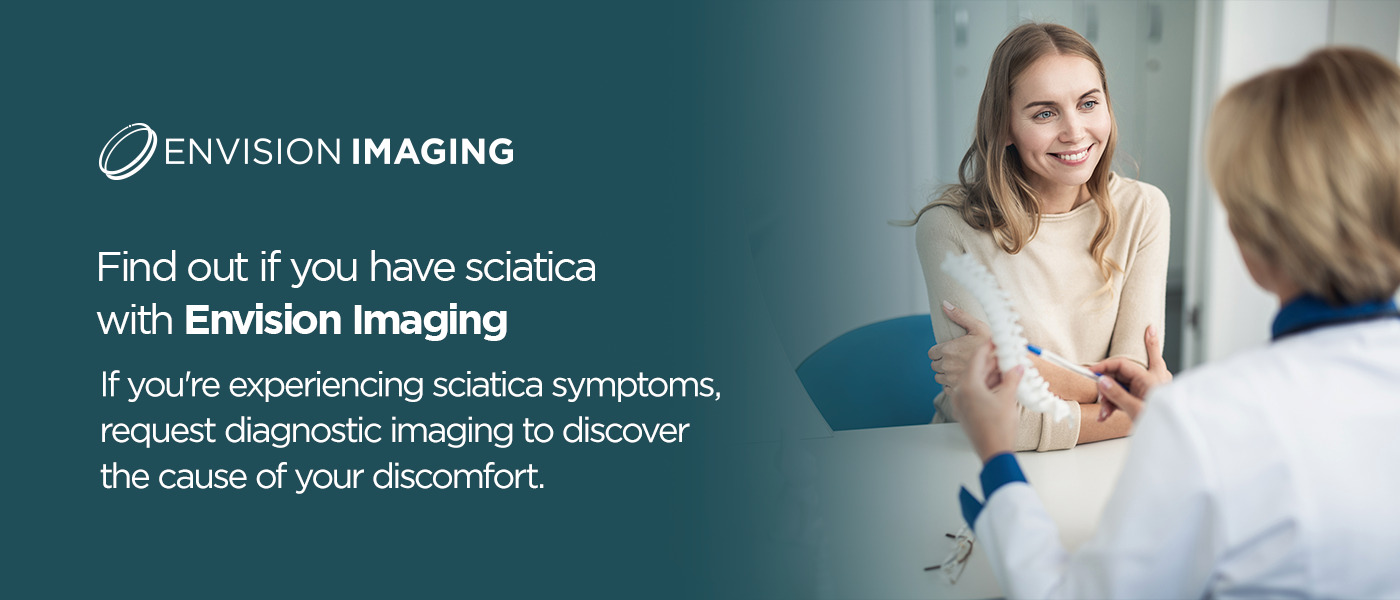How is sciatica diagnosed?
Sciatica is a condition many people experience as they get older. Nearly 40% of the population deal with sciatica during their lifetime. Receiving a sciatica diagnosis is the first step toward finding treatment to improve your health, comfort and happiness. Doctors will use a combination of your medical history, physical exam and medical imaging to diagnose sciatica. This guide will cover the signs and symptoms of sciatica and the types of testing doctors may use to diagnose your condition.
What is sciatica?
The sciatic nerve extends from your lower back, splitting at your hips and going through your legs and feet on both sides. It’s the longest nerve in your body, meaning it can cause significant pain when it’s under pressure.
Sciatica is a condition that typically results from a herniated disc in your lower spine. Discs are a soft, shock-absorbing material surrounded by a protective outer shell. When a disc is damaged, it can bulge, slip or rupture, pressing on the surrounding nerves. If the disc is near your sciatic nerve, this pressure often leads to sciatica.
Sciatica is essentially back pain that radiates from your lower back into your leg. It usually affects one leg at a time but can impact both in rare cases. Symptoms range from mild to severe and often include numbness or muscle weakness in your leg and foot. Most people can manage their symptoms with over-the-counter medication and light stretches, but chronic cases may require prescription medication, physical therapy or surgery.
Symptoms of sciatica
Sciatica symptoms vary for each person depending on where and how severely the nerve is impacted. Some people experience a few days of discomfort, while others find it challenging to move without intense pain. If you have sciatica, you may experience:
- Pain in your lower back, hips, buttocks or legs.
- Burning or tingling in one or both legs.
- Numbness, weakness or loss of movement in your leg or foot.
- Shooting pain that makes it challenging to stand.
- Discomfort in your lower body that worsens with movement.
Signs you should visit a doctor
If you’re experiencing mild sciatica symptoms, you can schedule an appointment with your doctor to receive diagnostic testing. However, you should seek medical attention immediately if you develop the following symptoms:
- You feel sudden, unbearable pain in your lower back or leg and muscle weakness or numbness in the same area.
- You lose the ability to control your bladder or bowels, a sign of cauda equina syndrome, which can lead to paralysis within 48 hours without treatment.
- You have a pulsating sensation in your leg or thigh.
- Your legs or feet feel cold or turn blue.
- You develop a leg infection that won’t heal.
- Your thigh, leg or lower back becomes swollen.
- Your pain began after a severe accident or injury.
Imaging and tests to diagnose sciatica
Doctors can tell a lot about your spine by reviewing your medical history and performing a physical exam. They’ll test your muscle strength, pain levels and mobility to determine the cause of your pain. Your doctor will likely order medical imaging to confirm their diagnosis. These tests may include:
1. Spinal x-rays
X-rays use low amounts of electromagnetic radiation to capture images of your bones and surrounding organs. The procedure is quick, simple and painless. You’ll lie down on an exam table while an x-ray technologist helps position your spine beneath the x-ray machine. They may shift your body a few times to capture multiple images. Each x-ray only takes a few seconds. The results are less detailed than other techniques, but they can detect tumors and bone spurs that may be pressing on your sciatic nerve.
2. Magnetic Resonance Imaging (MRI) scans
Many doctors use an MRI for sciatica diagnoses. Instead of radiation, MRI scans use a strong magnetic field and radio waves to capture high-definition images of your bones, tissues and organs. It’s one of the safest imaging techniques to capture herniated discs that may be causing your sciatica.
During the scan, you must lay as still as possible inside the machine while it captures images of your spine. How long this process takes varies depending on how many scans they need.
3. Computed Tomography (CT) scans
A CT scan is a powerful x-ray that can capture a 360-degree image of your spine, vertebrae and surrounding tissues. Like an MRI, you lay on a bed inside the scanner while it captures images of your body. CT scans are faster than MRIs, often taking 10 to 20 minutes.
Some doctors will also request a myelogram to diagnose your sciatica. The technologist will inject a special contrast dye into your spine before the CT scan to make the images more detailed. A myelogram helps doctors diagnose herniated discs, tumors, cysts and other conditions that may be causing your sciatica.
4. Electromyography (EMG) test
An EMG test is a minimally invasive procedure that measures how your muscles respond to electrical impulses from your nerves. It can detect pressure on your sciatic nerve from a herniated disc and other spinal conditions. The test is completed in two parts:
- Nerve conduction study: The first step is called a nerve conduction study (NCS). It measures the flow of electricity through your nerves.
- Needle electromyogram: The second step is called a needle electromyogram. It captures and records electrical signals from your muscles as they contract.
During the procedure, you’ll lay down on an exam table. To complete the NCS, the doctor or technologist will tape several electrodes to your skin. Small amounts of electricity are sent through the electrodes while a computer measures the signal speed as they pass from one electrode to the next.
For the needle electromyogram, your test provider will insert needles into the muscles they want to study. The needles are small and thin, causing minimal pain. Once inserted, the examiner will ask you to relax and contract your muscles. The needles will measure the electrical activity your working muscles create. EMG tests usually take 30 to 90 minutes. You may experience mild muscle soreness for a few hours after the procedure.
Find out if you have sciatica with Envision Imaging
If you’re experiencing sciatica symptoms, request diagnostic imaging to discover the cause of your discomfort. Receiving a diagnosis for your condition is the first step towards getting treatment and relief.
At Envision Imaging, our state-of-the-art imaging technology can help diagnose sciatica and many other spinal conditions. We deliver your scan results to your physician within hours to help you get answers as soon as possible. Our compassionate staff will make the experience as comfortable and stress-free as possible.
Browse our locations to request your next diagnostic imaging appointment. Our world-class facilities, compassionate care and accurate results ensure a pleasant and reliable experience.
Call To Schedule Your Appointment
Linked sources:
- https://www.health.harvard.edu/pain/sciatica-of-all-the-nerve
- https://www.aans.org/en/Patients/Neurosurgical-Conditions-and-Treatments/Herniated-Disc
- https://www.webmd.com/back-pain/guide/cauda-equina-syndrome-overview#:~:text=Cauda%20equina%20syndrome%20is%20a,permanent%20paralysis%20of%20the%20legs.
- https://www.envrad.com/services/x-ray/
- https://www.envrad.com/what-to-expect-when-getting-an-mri/
- https://www.envrad.com/difference-between-x-ray-ct-scan-and-mri/#what-is-ct-scan
- https://www.nhs.uk/conditions/ct-scan/
- https://www.envrad.com/services/myelogram/
- https://www.hopkinsmedicine.org/health/treatment-tests-and-therapies/electromyography-emg
- https://www.envrad.com/locations/




